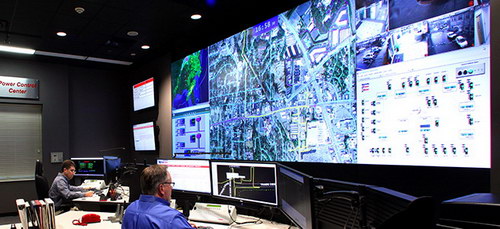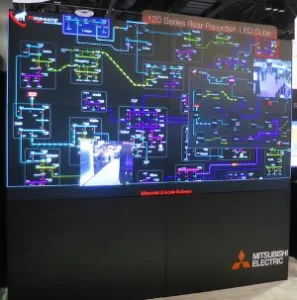When was the last time you saw a rear-projection television? For me, it was a week or so ago when my neighbor hauled his out of his house to the recycling yard. He replaced it with a new LCD TV. Beautiful, Full HD picture, high contrast, hangs on the wall.

His old DLP set was not HD and had a couple of stuck pixels. He put it in the corner so the depth didn’t make much difference. Time to move up – it was easier to replace the TV than replace the lamp. With baseball season here and football season coming, he didn’t want to risk missing anything if the lamp blew. Besides, now he can have friends in – the LCD has a much wider viewing angle than the old rear projection set.
If you go to the mall, airport or other venue and see a large display, it is almost certain to be either direct view LED or tiled LCDs. The only rear projection you are likely to see are Christie MicroTiles and similar displays. As far as I can tell, they are mostly used on-set as backgrounds for television shows. So rear projection is dead, right?
Well, maybe not quite. I was at Infocomm for only one day this year but I spent some of my time talking to representatives of Mitsubishi Electric about their rear-projection (RP) cubes for control room use. Mitsubishi is one of the major players in this market but I didn’t have time to see if the other players such as Christie, Barco, Eyevis or Planar were showing off their cubes.
Frankly, I didn’t really need to because the cube market changes fairly slowly and I’ve talked to them all in the past couple of years. This slow change in the available products is just fine with the cube customers. If you are running a telephone network, a power grid or a nuclear power plant, you don’t want your technology to change on you: you want it to work 24/7 for years on end. You want to focus on your network, not the displays that show you the status of your network.
 A 2 x 2 array of Mitsubishi 120 Series RP Cubes at Infocomm showing content representative of factory control.
A 2 x 2 array of Mitsubishi 120 Series RP Cubes at Infocomm showing content representative of factory control.
The last big innovation in RP cubes was about six years ago when LEDs started to replace lamps in professional rear projection cubes. By now the transition is complete, I doubt you could buy a new lamp-based RP cube if you tried. There are still a lot in the field, however, so Mitsubishi sells a replacement LED-based DLP engine for their customers that still have lamp-based systems. Since Mitsubishi alone sold about 45,000 RP cubes with lamps and customers tend to keep a RP cube installation for years, even decades, there are still a lot in the field.
From a customer’s point of view, replacing an engine with a 10,000 hour UHP lamp with an engine with a 100,000 LED without needing to tear out the complete wall makes sense. 10,000 hours is 1 year, 1.9 months at 24/7. I’d been told that customers sometimes schedule once a year maintenance and replace all the lamps, whether they need to or not. 100,000 hours is 1 decade, 1.6 years. Maybe customers will start scheduling their regular maintenance once a decade in the future.
 LG Spokesman unveiled the new VH7B series of 1.8mm bezel LCDs for tiled applications at Infocomm.
LG Spokesman unveiled the new VH7B series of 1.8mm bezel LCDs for tiled applications at Infocomm.
As a counterpoint to RP cubes, I went to the LG press breakfast where they unveiled a new, tileable LCD panel with a total picture-to-picture bezel of 1.8 mm. It looked good and was only marginally visible at normal viewing distance. Of course, a RP cube system has, typically, a 1.0mm picture to picture distance and some have only 0.5mm.
Tiled LCDs have several advantages over tiled RP cubes. First, they mount directly on the wall, no space behind them is needed. While some RP cubes can be serviced from the front and need no space other than the 12” (30 cm) or so depth of the cube, many require a walkway behind them for rear service. Second, tiled LCDs are cheaper – a big advantage for shopping mall installation.
LCDs have a limited life. At the end of that life, typically the whole wall is taken down and thrown away (or, hopefully, recycled). For a shopping mall, this is fine – something new is always something good. If you want to manage the Tokyo subway system, disassembling and rebuilding your control room every year or so is just not acceptable.
 Marietta Power’s new display wall using eight 67” Mitsubishi SXGA+ projection cubes
Marietta Power’s new display wall using eight 67” Mitsubishi SXGA+ projection cubes
There you have it – for casual use and low-end control rooms that are used only part time, LCDs are just fine. If you are Marietta Power and have 46,000 customers who get very peeved if the lights go out, there is still no substitute for rear projection cubes. – Matthew Brennesholtz

